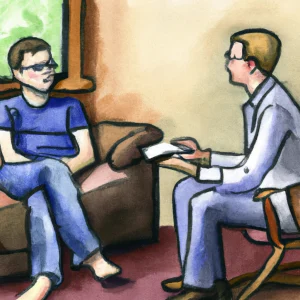What's Here? - Table of Contents
The mental health crisis in the United States is a significant problem that affects both adults and children. According to the National Institute of Mental Health (NIMH), in 2021:
- An estimated 44.7 million adults in the United States (about 18.7% of the adult population) had a mental illness.
- An estimated 13.1% of children aged 2-17 (about 8.4 million children) had a diagnosed mental, behavioral, or developmental disorder.
As you can likely surmise, mental health problems are common and are having a significant impact on individuals and their families.
What are Mental Health Problems/Illnesses and how are they defined?
Mental health problems can range in severity, from mild to severe. Some people may experience symptoms that are relatively mild and manageable, while others may experience more severe symptoms that significantly interfere with their daily lives.
In the United States, mental health illnesses are defined in the Diagnostic and Statistical Manual of Mental Disorders (DSM), which is published by the American Psychiatric Association. The DSM is a standard classification of mental disorders used by mental health professionals.
The DSM includes definitions and criteria for diagnosing mental disorders. For each disorder, the DSM includes a list of symptoms and a set of criteria that must be met in order to make a diagnosis. The DSM also includes information on the prevalence, course, and treatment of each disorder.
The DSM is revised periodically to reflect new research and developments in the field of mental health. The most recent version of the DSM is the DSM-5, which was published in 2013.
The DSM-5 organizes mental disorders into different categories based on the type of disorder and the specific symptoms that are present. Some of the main categories of disorders in the DSM-5 include:
- Anxiety disorders: Anxiety disorders, such as generalized anxiety disorder, social anxiety disorder, and panic disorder, are characterized by excessive worry or fear that is not proportional to the situation.
- Mood disorders: Mood disorders, such as major depression and bipolar disorder, are characterized by changes in mood that are more severe or prolonged than what is normal for the individual.
- Substance use disorders: Substance use disorders, including alcohol and drug addiction, are characterized by a pattern of substance use that causes significant problems in an individual’s life.
- Personality disorders: Personality disorders, such as borderline personality disorder and narcissistic personality disorder, are characterized by long-term patterns of thoughts, feelings, and behaviors that are significantly different from the norm.
- Schizophrenia: Schizophrenia is a severe mental disorder characterized by a disconnection from reality and abnormal thought processes.
Mental Health Illnesses Among Adults
Mental health issues are a significant problem in the United States. According to the National Institute of Mental Health (NIMH), in 2021, an estimated 44.7 million adults in the United States (about 18.7% of the adult population) suffered from some form of a mental illness.
Among adults the most common mental health problems in the United States currently include:
- Anxiety disorders: Anxiety disorders, such as generalized anxiety disorder, social anxiety disorder, and panic disorder, are the most common mental health problems in the United States, affecting about 18.1% of adults.
- Mood disorders: Mood disorders, such as major depression and bipolar disorder, are the second most common mental health problems in the United States, affecting about 9.1% of adults.
- Substance use disorders: Substance use disorders, including alcohol and drug addiction, are a significant problem in the United States, affecting about 8.4% of adults.
- Personality disorders: Personality disorders, such as borderline personality disorder and narcissistic personality disorder, affect about 6.9% of adults in the United States.
- Schizophrenia: Schizophrenia is a severe mental disorder that affects about 1.1% of adults in the United States.
** It is important to note that these figures are estimates and that the prevalence of mental health problems can vary depending on the methods used to collect and analyze data. Additionally, many people with mental health problems may not seek treatment, so the true prevalence of mental health problems in the United States may be higher.
Mental Health Among Children and Young Adults
Mental health problems are also a significant issue among children and young adults in the United States. According to the National Institute of Mental Health (NIMH), in 2021:
- An estimated 13.1% of children aged 2-17 (about 8.4 million children) had a diagnosed mental, behavioral, or developmental disorder.
- The most common mental health problems among children and adolescents were attention-deficit/hyperactivity disorder (ADHD), behavior or conduct problems, and anxiety disorders.
- An estimated 3% of children aged 2-17 (about 1.9 million children) had a severe mental illness.
- An estimated 25.8% of young adults aged 18-25 (about 6.3 million young adults) had a mental illness.
- The most common mental health problems among young adults were major depression, substance use disorders, and anxiety disorders.
How do Social Workers help address mental health issues?
Social workers play a critical role in addressing the mental health problem in the United States. They are trained professionals who help individuals, families, and communities to cope with and solve problems related to mental health, substance abuse, poverty, and other social issues. They provide a wide range of services, including counseling, advocacy, and support to people who are struggling with mental health problems.
More specifically, social workers provide the following services to address mental health problems acutely and from a macro perspective:
Providing counseling and therapy
Social workers can provide individual, family, and group therapy to help people with mental health problems to cope with their symptoms and improve their well-being.

